By Tom O’Leary
While most countries in East Asia and the Pacific (China, South Korea, Thailand, Australia, New Zealand etc) have reduced the number of daily coronavirus and deaths to essentially close to zero a number of countries, particularly the US and in Western Europe, have begun to ease lockdown measures even though the spread of the coronavirus has not been decisively halted. Both logic and experience are clear that this latter path is the wrong way around to defeat the spread of the virus. In addition, the World Health Organisation has already warned of a second peak in cases.
Instead lockdowns should continue until some time after it is clear that the virus is at a manageable level – defined as at most less than a few dozen cases and that full tracking, tracing, testing and isolation regimes are in place.
Of course, the trajectory of the virus’ spread matters to each individual country. It matters for every other country too, given the global spread of the pandemic. It is also important to learn lessons from each other, to avoid the worst effects of the pandemic and to mitigate them as far as possible.
Unfortunately, European countries in general have been extremely reluctant to learn from the countries of the Asian Pacific who have successfully combated the virus. So, Germany is held up as an exemplar of how to respond to the crisis, when in a global perspective it is nothing of the kind. This is illustrated in Chart 1 below, which shows the per capita death toll in Germany versus key Asian Pacific countries. It clearly shows the death toll is catastrophically worse in Germany (all data throughout from Our World In Data throughout, unless specified).
Chart 1. Deaths Per Million in China, Germany, New Zealand and South Korea
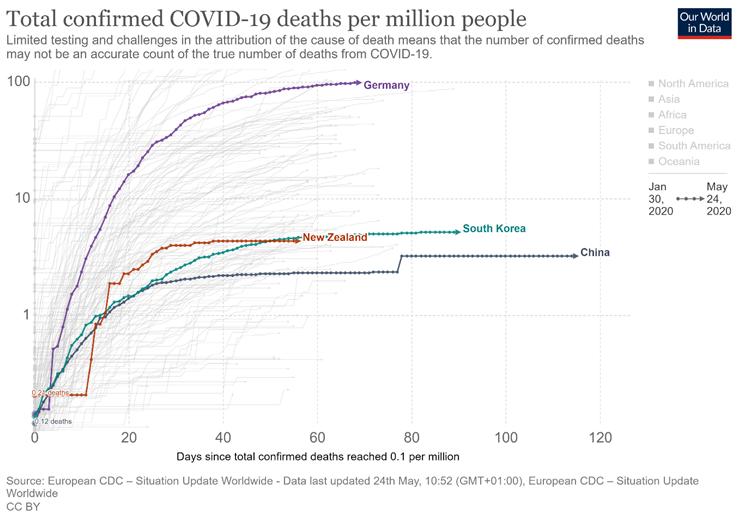
The data makes this disparity even more stark. Table 1 below shows the death total of each of the 4 selected countries in Chart 1.
Table 1. Cumulative Total Covid-19 Deaths for Selected Countries, per million
| Total | |
| China | 3.3 |
| New Zealand | 4.3 |
| S Korea | 5.2 |
| Germany | 99.5 |
Source: Our World in Data, based on FT analysis of data from the European Centre for Disease Prevention and Control and the Covid Tracking Project.
The unwillingness to learn from other countries with far greater success in combating the virus is combined with highly distorted coverage of those countries in Western media. So, the reports of flare-ups of the virus in both China and South Korea were treated with a mixture of derision and misinformation. The implication has been that the Asian Pacific governments have been extreme in their response and unsuccessful. As the comparative date above shows, both of these points are untrue. The Asian Pacific countries have put public health first, unlike the Western governments, and despite a few missteps they have been remarkably successful.
By contrast, in their back-to-work propaganda campaign, Western governments increasingly rely on the completely false assertion that ‘it is impossible to defeat the virus and we have to live with it.’ Yet many of the Pacific Asian countries have demonstrated the opposite, including those cited above. Many have recorded no new deaths for weeks.
Learning from Europe
However, it is also possible to learn from the missteps of others. In this respect it is unfortunately the case that Europe provides plentiful examples, especially now on the premature easing or ending the lockdowns. This is true even in countries which are relatively successful in combating the spread of the virus, at least on a European scale.
- Countries where new cases are rising
This is illustrated in Chart 2 below. This shows two European countries where it is clear that the death toll has started to rise once more, Poland and the Czech Republic.
Chart 2. Daily New Coronavirus Cases in Poland and the Czech Republic, 7-day moving average
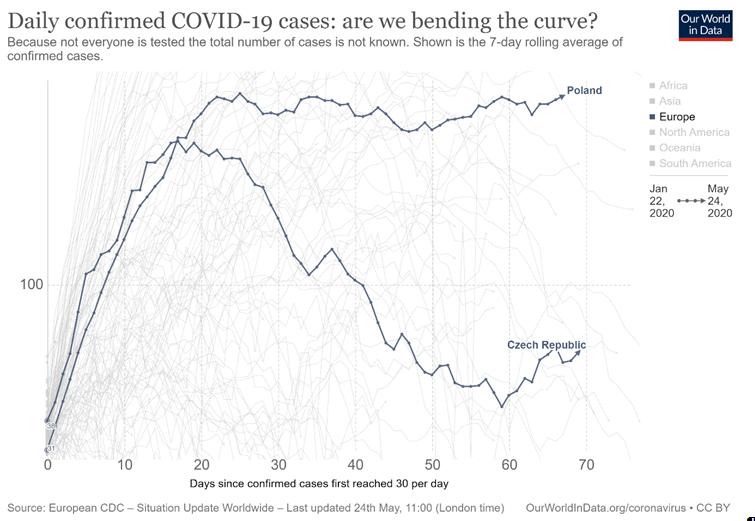
The Czech Republic hit a low-point in new cases of 42 on April 27 and these have since risen to 62. Poland reached a low of 296 new cases on a 7-day moving average basis on May 5 and they have since risen to 382.
At this point, the analytical tools provided by Our World in Data are very valuable. Among many other categories, there is also data on policy changes in relation to the lockdown. In relation to Poland, the data shows that stay-at-home restrictions on were introduced on March 31st, but eased again on April 9th. At the same time Poland has no systematic regime for contact tracing at all. In the Czech Republic the lockdown on schools was eased on May 11 and the lockdown for all but essential workers was eased on April 20. Stay-at-home restrictions were eased one day later, while internal restrictions on movement had been eased on April 2nd.
- Countries where new cases are no longer declining
There are also a number of European countries where the fall in new cases has halted. Hopefully this is temporary, but the previous downward trends in new cases has come to a stop for now. Chart 3 below shows the 7-day moving average for new cases in Spain, Austria and Norway. Hungary could also have been included, but has been omitted for clarity in the chart.
Chart 3. Daily New Coronavirus Cases in Spain, Austria and Norway, 7-day moving average
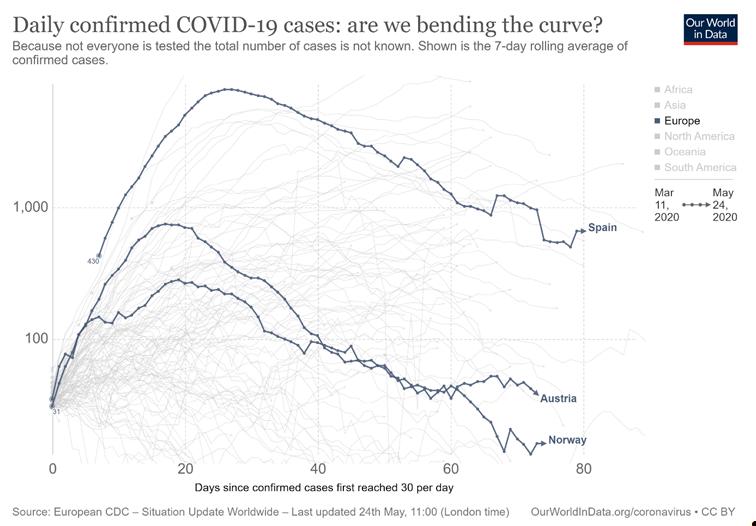
From the chart above it is clear that new cases in all 3 countries are no longer falling. The latest level of Spanish new cases is higher than they were six days ago. The downtrend in Norwegian cases has stalled. There has effectively been no decline in Austrian cases since May 7.
Austria and Norway removed restrictions on all but essential work on April 18 and April 20 respectively. The following day Norway also eased restrictions on public gatherings, but partly reversed course on May 11, while Austria eased these type of restrictions on May 2. Norway partially lifted restrictions on schools on April 20 and again on May 11. Austria reopened schools on May 18, having lifted the stay-at-home order on May 1st.
It should be noted that, despite much publicity, Spain is not categorised as having lifted any restrictions within these data. This is because, having been very late into lockdown after the virus had spread, the eventual easing of restrictions by the Spanish authorities was extremely limited. Allowing children out very briefly, plus limited opportunities to exercise and the partial reopening of bars and restaurants for takeaway and delivery services which took place at the end of April and beginning of May had always been allowed in Britain’s rather lax lockdown, for example.
- Countries where the downtrend in cases has slowed
Germany is not an exemplary country in fighting the virus, as previously noted. Even so, Germany still has one of the better trajectories in combatting Covid-19 among the large European countries.
Yet Germany risks falling into a category of countries where lockdown measures have been eased but the fall in cases has slowed. This is illustrated in Chart 4 below.
Chart 4. Germany and China New Coronavirus Cases, 7-day moving average
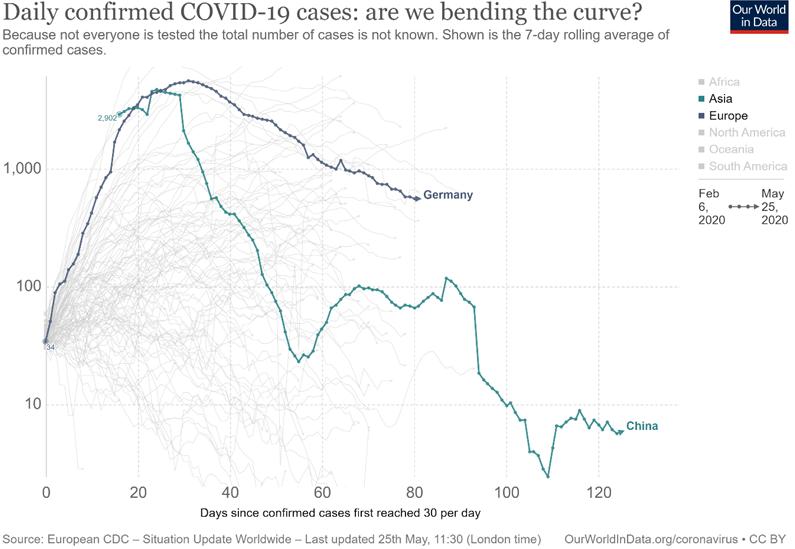
On May 23rd Germany was in its 83rd day of coronavirus cases, with a total of 561 new cases per day. At the same period in the spread of the virus in China cases had fallen to 102 cases. As the chart clearly shows, Germany is not crushing the spread of the virus in the way that China and other Asian-Pacific countries have.
But it has also eased lockdown measures, unlike China and other countries. The effect has not been to produce a rise in new cases, or even a halt to that decline. However, the rate of decline has slowed quite soon after the lockdown was eased. Germany eased the lockdown on schools on May 4, but otherwise most measures have stayed in place.
Following this measure, the fall in German cases has slowed. On May 6 German new cases had slowed to 1,000 per day. They have since fallen by 44% to 561 per day. However, in the preceding 17-day period they had fallen by 62.5%. This slowdown may only appear incremental, but the effect is to create hundreds of additional cases per day. Worse, the real negative effect of easing should only become apparent up to 14 days later given the incubation period and lags in testing and results. Using a 7-day moving average to smooth daily volatility will add a further delay before substantial changes become apparent.
So, the concern is that a definite slowdown in the new case rate in Germany after easing the schools’ lockdown may only be registered in the data from now onwards, in the last week of May. Many other countries where lockdown has been eased are in a similar position. In both France and Finland it is reported that some schools were closed once more because of new outbreaks.
The case of Britain
It is widely understood that in the UK new cases are falling. But it has already been shown that a simple fall in new cases is insufficient to prevent a reversal once lockdown is eased.
Two conditions need to apply. The first is that the number of new cases has fallen to such a level that each new case can be identified, and the second is that the contacts of each new case can be rapidly tracked, traced, tested, and where necessary placed in isolation. Neither of those conditions currently applies in this country.
Table 2 below shows the number of cases in each of the European countries cited in this piece at the time lockdown was eased. It also shows, using the Our World In Data categories, what the type of testing and tracing regimes were in place at the time of that easing. UK is also shown for comparison.
Table 2. Selected European Countries, Cases Per million and Testing & Tracking Regimes When the Lockdown Eased
| Cases per million | Testing | Tracking | |
| Poland | 9.9 | Targeted | None |
| Czech Republic | 11.5 | All persons with symptoms | Comprehensive |
| Austria | 13.8 | All persons with symptoms | Comprehensive |
| Norway | 16.8 | Targeted | Limited |
| Spain* | 24.4 | Targeted | Limited |
| Germany | 13.0 | Targeted | Limited |
| UK | 37.6 | Targeted | None |
Source: Our World In Data
*Spain’s actual ease of lockdown begins on May 26 with a partial school reopening
It should be clear that the UK is in no position to begin easing lockdown at all. This comparative group comprises countries where the fall in in cases has either slowed, or stalled altogether, or where cases are rising once more. Yet in all cases, the UK number of new cases per million is still far in excess of any of these when they eased their respective lockdowns.
In addition, the required system of tracking, tracing, testing (and where necessary isolation) is simply absent. It is already the case that the UK system of testing is wholly inadequate, and not just because the government repeatedly misses its own target of 100,000 people tested each day.
The UK mortality rate (deaths per case) is currently 14.3%. This compares to a European average of 8.7% and a global average of 6.5%. There is no suggestion that the UK is faced with a particularly virulent strain of virus. Instead, the clear implication is that the testing regime is extremely poor, capturing only half of the proportion of cases that are recorded elsewhere.
Currently the UK is still recording an additional 3,000 or so cases per day. It has been shown elsewhere that each new case presents between 50 and 60 contacts that need to be tracked and tested. This implies a further 150,000 to 180,000 additional test per day, when even the current requirement cannot be met.
Finally, there is no contact tracing mechanism in place at all. Instead, we have the Isle of Wight app, which has disappeared into the same rabbit-hole as the Dyson ventilators.
The UK has an extraordinarily high new case rate, despite a limited level of testing which artificially depresses those numbers. For example, the Office for National Statistics estimates that the new case rate is 9,000 per day. Any easing of lockdown would require a massive increase in the current rate of testing in order to cope with just the currently identified cases. And there is no system in place at all for tracing those contacts of new cases. None.
The government says it will make a decision on easing lockdown on May 28 and the Prime Minister now insists once more that schools will re-open on June 1. Now is the time to apply maximum pressure to resist this reckless decision with predictably dire consequences.

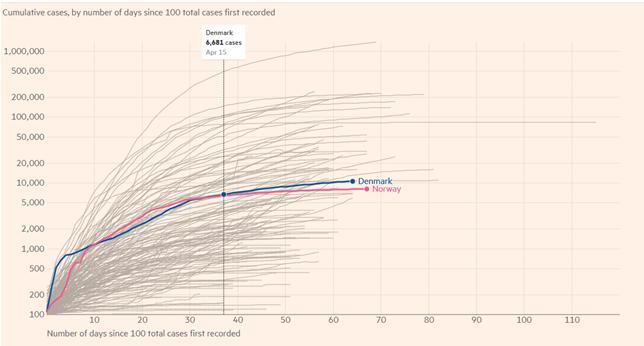
Recent Comments